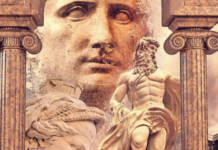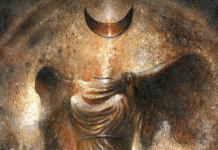 A kind of prophet of the imagination, Michael Parkes fills his paintings with beasts and landscapes that, like dreams, seem too real to be fantasy, and too fantastical to be real. In his worlds, one can find the most intense conversations happening on tightropes and ledges, in skyscapes that hearken to the artistic styles of Maxfield Parrish and Sir Lawrence Alma-Tadema. Here, pompous gnomes with pointed shoes watch over tiptoeing dancers, while eyeless jesters strum silent melodies on violins. Each artwork is an adventure; each figure a wormhole into an ocean of chimeric secrets.
A kind of prophet of the imagination, Michael Parkes fills his paintings with beasts and landscapes that, like dreams, seem too real to be fantasy, and too fantastical to be real. In his worlds, one can find the most intense conversations happening on tightropes and ledges, in skyscapes that hearken to the artistic styles of Maxfield Parrish and Sir Lawrence Alma-Tadema. Here, pompous gnomes with pointed shoes watch over tiptoeing dancers, while eyeless jesters strum silent melodies on violins. Each artwork is an adventure; each figure a wormhole into an ocean of chimeric secrets.
Parkes has been categorized as an abstract expressionist and a magical realist, but not much has been said about the spiritual dimensions of his art. I’d like to take a brief look at what seem to be key themes and symbols that regularly appear in his paintings. To do this, I’ve chosen three of my favourite Parkes paintings; Ceremony of the Sun, Water Music, and The Juggler.

Ceremony of the Sun is a piece of beginnings, like The Fool in tarot. In the Rider-Waite-Smith Tarot, illustrated by Pamela Coleman Smith, The Fool is represented by a youth who is carelessly striding off the edge of a cliff. His eyes look heavenward and he holds a white rose in his hands, a symbol of innocence and purity. A dog also nips at his heels, as if to warn him of his impending doom. Like the tarot image, which in many interpretations symbolizes burgeoning spiritual awakening, Parkes’ Ceremony of the Sun is initiatory; a narrative of a spirit’s journey into the great beyond.
Monastics in white habits usher the initiate down the steps; one of them attaches wings to her back. This may represent an optimistic message deriving from the Neoplatonic belief in the winged soul’s return to the stars. Alternatively, it can also serve as an analogy to the cautionary tale of Icarus. In mythology, Icarus, the son of the great inventor Daedalus, perished when he disobeyed his father’s instructions during their escape from Crete — choosing to fly too close to the sun. It is pride — the stereotypical bane of all youth — that ultimately takes his life.
Although the woman does not hold a rose, there are a white cat and two white birds (possibly doves) waiting for her at the bottom steps. In her hands, the woman holds a sphere, a symbol for completion. Not surprisingly, the classical Greek word for completion (teleios) also means perfection. It appears both in the references to sanctification in the New Testament and in references to the aim of the ancient mysteries of Eleusis.

Water Music can be puzzling at first glance. What’s with the disappearing frog? Why is the musician’s hand transforming? And what’s with that creepy smirk? Water Music has many similarities to the vanitas and memento mori paintings of the Baroque era. These still life portraits popularized the motto memento mori, which means “remember you will die.”
In Water Music, the musician’s life is the music, which he happily plays with a blindfold. For the most part people tend to live their lives playing along with their own matrices of compositions, blissfully unaware of their imminent end. Like a human’s vanishing life, the violinist’s hand and the frog are partially vanishing into thin air. The two swans foreshadow funerary rites; one ‘tolls’ a bell, the other offers a flower for consolation.

The Magician tarot card is conjured in The Juggler. While the smiling acrobat-clown conducts his impossible balancing act, connecting heaven and earth with his outstretched arms and legs, a young girl looks on, contemplating the master’s grace. The juggler poses on a looped rope, which is possibly a reference to the infinite circle of the ouroboros. The painting even has aspects of a cosmic dance, like that of the most popular sculptures of Shiva.
The master juggles three balls, but there are also three placed behind the girl. Could these be the six planets? Might the juggler also represent the sun?
Parkes himself has a deep history with ballet and Indian philosophy. His works have inspired at least one ballet production, and he spent significant time living in India and pursuing various spiritual paths before he decided to become a full-time artist.
These are only a small portion of all of the wonderfully insightful works of Michael Parkes. Taken together, the three paintings reveal dramatic realities about perennial themes of human concern, namely the perilous but rewarding nature of mysticism, the importance of the awareness of death, and the naked beauty of a mastered willpower.








